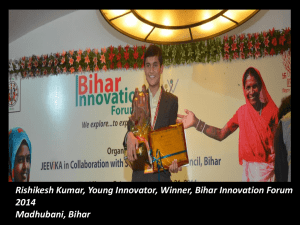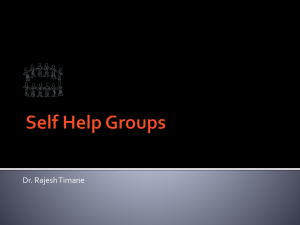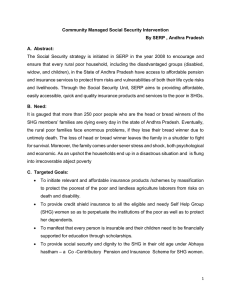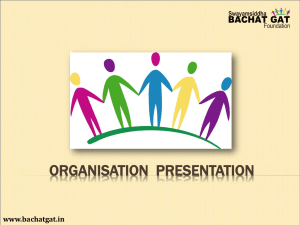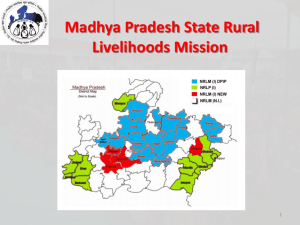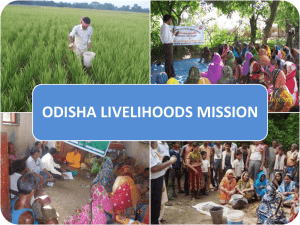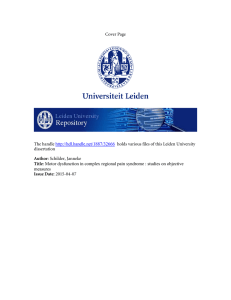raja_pratap
advertisement
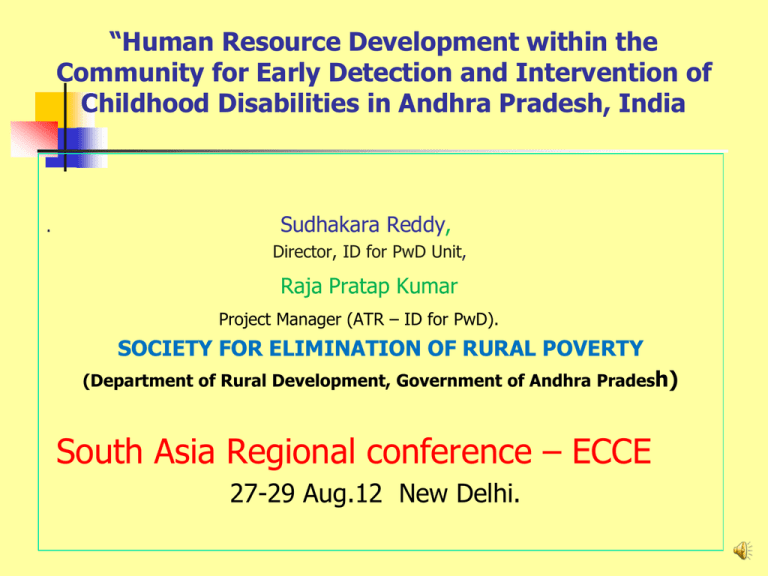
“Human Resource Development within the Community for Early Detection and Intervention of Childhood Disabilities in Andhra Pradesh, India . Sudhakara Reddy, Director, ID for PwD Unit, Raja Pratap Kumar Project Manager (ATR – ID for PwD). SOCIETY FOR ELIMINATION OF RURAL POVERTY (Department of Rural Development, Government of Andhra Pradesh) South Asia Regional conference – ECCE 27-29 Aug.12 New Delhi. India & Andhra Pradesh Society for Elimination of Rural Poverty (SERP) The project implementing agency is the Society for Elimination of Rural Poverty, an autonomous Society registered under Public Societies Act. The Chief Minister is the Chairman of the General Body. Management of the society is vested in an Executive council working under the Department of Rural Development Government of Andhra Pradesh. Objective of SERP To enable the rural poor in the state, particularly the poorest of the poor to improve their livelihoods and quality of life. Creating self-managed grassroots level institutions of the poor, namely Women SHGs their federations Village Organisations (VOs) & Mandal Samakhyas (MSs). Disability program Objectives Enhancing livelihood opportunities and quality of life for person with Disabilities (PWDs) and their families Ensure Optimum utilization of residual abilities by PWDs Improve capacities of PWDs to access and avail various entitlements and services offered by the Government. Mainstreaming disability concerns in policy making and activities of line departments Key Interventions Social mobilization and Institution Building of PwDs and their caregivers Provision of Livelihood support Community based Rehabilitation Services Promoting convergence with line departments of Health and Education for inclusive activities Social Mobilization & Institution building. Self help group (SHG) at village level Community Based Organization Organogram CBOs of Women CBOs OF PERSONS WITH DISABILITY. ZS ZVS MS MVS MVS MVS VO SHG SHG SHG SHG SHG SHG SHG SHG SHG SHG STAFF PATTERN OF SERP – IKP. CEO Director PD District level PM/DPM CC CC CC CDW CDW CDW Sub District level Cluster level Objectives of the Present Project. Early detection intervention in early years arrests further damage to children with disabilities/at risk for disabilities. Generating human resources within the community will aid in identifying such children early for further referral/intervention and ensure sustaining of the programme resulting in ownership by the community Community Resource Person (CRP) Person who is a member SHG of PwD or a care giver of person with disability residing in the sub district (mandal). The selection criteria for CRPs. Should be women with disability. Should be a at least 18 years of old. Care givers of intellectual disability would be given preference. Should be educated minimum up to VIII standard. Should have the aptitude and commitment for the selected task. Mandal Vikalangula Samakhyas (Federation of PwD) is responsible for selection and monitoring the work of CRPs. Capacity building Hands on training Participatory training Methodology of Capacity Building Lecture method. Presentations Participatory exercises Experiential learning Exposure visits (field visits) Supportive supervision visits Topics covered under Capacity Building Causes and prevention of Developmental delays. Assessment of developmental delays Training on APGAR Score. Intervention support Training on case history documentation Survey for identification of CWDD. Counseling skills. Referrals and follow up. Training Parents/ care givers Capacity building of the CRPs. Empanelment of Training and referral Institutions NIMH, Secundrabad NIHH, Secundrabad LV Prasad Eye Institute, Hyderabad. Sravanam – Institute for Hearing Impaired. Abhivrudhi – Institute for DDs. NIMS, Hyderabad. BIRRD, Tirupati. SVS Hospital, Mahboobnagar BMVS, Hyderabad. Quality Assessment tools for Capacity Building Pre test and post test questionnaires. Ongoing Supportive supervision visits through subject experts. Case study documentation. House visits by CRPs & professionals. Timely submission of MIS reports Home visits by the team CRP home visit & support Home visits by professional & CRP Strategy Adopted Identification: Door to door survey Identify Counsel Referral to required services. Intervention: Brining to NH center. Assessment by professional. Intervention support Follow up by CRPs, Professionals and Parents. Convergence with line departments Village level: PRIs, Anganwadi workers, ASHA workers, ANMs and SSA. Mandal Level: PHCs, Area hospitals, NGOs, ICDS officers. District level: Disabled welfare, Health department officials, ICDS, SSA . Impact of the intervention Increase in awareness levels on DDs among women. Effective utilization of Manopragathi (Center Based Training). Neighborhood centers have been nurtured as Early intervention centers. Increase in skill set of care givers towards CWDDs. developed resource pool (ASHA, Anganwadi, Health activists and ANMs) for identification of CWDDs. Purnima’s intervention & transformation Beginning stage Intervention support Contd…. Attending school & escort to her sister Encouragement of the teacher at school Early Intervention support to Delayed Development children(0-6 Yrs) Sl.No. Particulars Details 1 No.of Mandals(Sub-Districts) 100 2 No. of Community Resource Persons(CRP) Deployed. 100 3 No. of villages covered till now. 4 No.of children screened(0-6 Yrs) 5 No. of Children with Delayed development identified. 2372 6 No of CwDD undergone detailed assessment 2292 1556 283880 Contd… Sl.No. Particulars details 7 No of persons utilized neighborhood center services 1311 8 No of persons benefited through manopragathi programme 2292 9 No of parents trained under early intervention programme 2012 10 No of children shown signs of improvement 416 11 No of children enrolled in Anganwadis 108 Neighbourhood Centre: A Neighborhood Centre is a place designed to have all members in the community including those with without disabilities to come together and spend time in a relaxed and enjoyable manner. Recreation with ADL skills training by professionals at Neighborhood centre. Functions of Neighbourhood Centre To serve as a place where persons with and without disabilities can be together . To function as a place where therapeutic equipment for Physiotherapy, occupational therapy and so on are available, can be used on the advice of the therapists. To serve as a play centre where small children with developmental delays can receive stimulation activities. To function as a referral centre for medical, educational, certification and legal issues for PwDs who approach with queries. To provide respite care services to parents of young children with developmental delays. Activities at Neighborhood centre Play therapy Inclusive Play with children with DD Manopragathi It’s a programme which acts as a catalyst for effective utilization of therapeutic interventions carried out by qualified professional at local level. It is organized once in every fortnight people are mobilised by CRPs. All needy persons can access the services of manopragathi. Updating of medical records and documentation of success stories are being done. The programme is managed by community. Professional Services at Manopragathi Programme. Physio therapy Speech therapy Capacity Building to parents/care givers of CwDDs Regular training programmes (once in 3 months) is being organized for the parents and care givers. Professionals and CRPs preside as trainers for the programme. Regular counseling is carried out with the care givers. Training to Care givers by Physiotherapist Training to parents/caregivers by CRP Effect of the intervention SERP has developed strong institutions (SHGs and federations) at the village level, Sub district and district level. The programme has been successful because its driven by the community. It is being managed by the community and their families. Committed trainers with vernacular background. Effect of intervention Future plans Would be scaled up to all mandals of Andhra Pradesh. Ensure sustainability through involvement of PRIs and other line departments. Furnish data on children with Developmental Delays to the concerned government departments. Tracking the progress of development using mobile technology. Acknowledgments Mr.Rajsekar,IAS, CEO of SERP. Sri. Sudhakara Reddy, Director, ID for PwD. Dr.Jayanthi Narayan.Former Dy.Director, NIMH, Dr.Swapna, Early Intereventionist, Dr.George Reddy, Psychriatrist, Mrs.Beula, L.V.Prasad Eye Institute. Prof.Hari Prasad, NIHH,Hyderabad Sravanam DRC. Hyderabad. CRPs & families. THANK YOU

